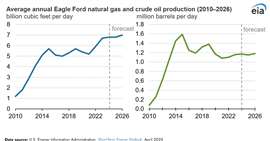Eagle Ford gas production set to climb
April 14, 2025
EIA says output likely to grow through 2026

Natural gas production in the Eagle Ford region of southwest Texas is projected to continue its upward trajectory over the next two years, according to the U.S. Energy Information Administration (EIA). In its April Short-Term Energy Outlook, the EIA forecasts that annual natural gas output in the region will rise from 6.8 billion cubic feet per day (Bcf/d) in 2024 to 7.0 Bcf/d in 2026.
The growth in natural gas production comes amid rising natural gas prices and increasing global demand for liquefied natural gas (LNG) exports. In contrast, oil production in the Eagle Ford has remained relatively flat, averaging around 1.1 million barrels per day (b/d) since 2020, and the EIA expects it will stay near that level through 2026.
The production trends are being driven by rising gas-oil ratios in the region’s reservoirs. As oil and gas wells mature and pressure within the reservoirs declines, more natural gas is produced relative to oil.
The Eagle Ford region encompasses several plays, including the prolific Eagle Ford and Austin Chalk formations. Development in the Austin Chalk began nearly a century ago but has experienced a resurgence since 2014. Since then, oil production from the play has nearly quadrupled, while natural gas output has surged by nearly 675%.
Currently, the Eagle Ford play accounts for 73% (5.5 Bcf/d) of the region’s natural gas production and 86% (1.0 million b/d) of its oil production. Since 2020, natural gas production from the play has grown by 10% (0.5 Bcf/d), while oil output has dipped by 4% (46,000 b/d).
Meanwhile, the Austin Chalk play makes up 23% (1.8 Bcf/d) of the region’s natural gas production and 11% (125,000 b/d) of its oil production. It stands as the fastest-growing play in the region, with natural gas production nearly tripling (up 1.1 Bcf/d) and oil production increasing by 26% (26,000 b/d) since 2020.
The EIA’s latest projections underscore the evolving dynamics of the Eagle Ford region as operators respond to market forces and changing reservoir conditions.
MAGAZINE
NEWSLETTER
CONNECT WITH THE TEAM







